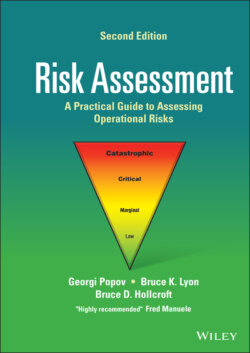Читать книгу Risk Assessment - Georgi Popov - Страница 32
2.2 Risk Assessments and the Safety Professional
ОглавлениеFundamentally, the safety profession has long recognized the importance of managing hazards and risk through proper identification, assessment, and control. This is reflected in the standards, guidelines, and best practices found in various industries and business segments such as environmental, financial, medical, and nuclear, among others that require or recommend risk assessment. Some of these business segments are covered by regulatory compliance requirements, specific to their industry.
In the first chapter, an addendum can be found listing standards, guidelines, and initiatives that have been established since 2005, which require or promote the use of formal risk assessments. A review of these standards and guidelines reveals that there are similarities and differences in the approaches taken by their drafters. Some are industry specific, while others apply across all industries. The message they give is clear: risk assessment is important, and safety professionals are expected to be knowledgeable and skilled in their application.
To avoid professional liability risk, it is important for safety professionals to be knowledge of current applicable standards and best practices. In addition to regulatory standards, consensus standards such as ANSI/ASSP Z590.3, ANSI/ASSP/ISO 45001, and ANSI/ASSP/ISO 31000 considered best management practices (BMPs) should be used and recommended by safety professionals. In the event of an accident, compliance alone does not protect organizations or individuals from legal actions, especially if there is a known consensus standard available that could have prevented or reduced the risk. In such cases, “foreseeability” comes into play.
Foreseeability is a legal theory which states that someone is responsible for causing another person’s injuries if they were aware that their actions may have detrimental effects, did not change these actions or make the necessary adjustments, as well as causation between their action and the injury. For instance, a safety professional may be asked to testify in a legal case regarding their knowledge of current consensus standards that have relevance to the incident. The question might be “Are you aware of any standards related to this issue?” If the answer is “No,” the safety professional is discredited. However, if it is “Yes,” the very next question might be “Why didn't you apply the BMPs recommended by the standards?”
It has become clear that relying on a compliance‐based approach is no longer adequate. While being compliant is necessary and required by law, it only establishes the minimum level of acceptability. A risk‐based approach takes a deeper dive to truly understand the cause of injury/loss and encourages organizations to proactively assess their risks.
